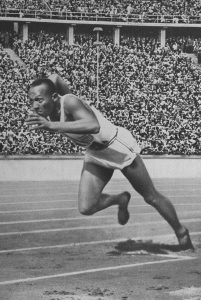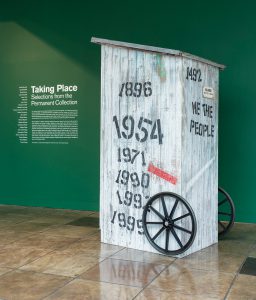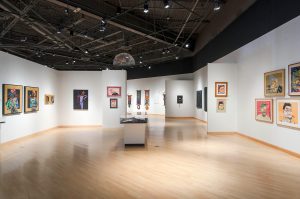With the 40th anniversary of its state charter this year, the California African American Museum (CAAM) is in the midst of an institutional reinvigoration, deepening its mission “to research, collect, preserve and interpret for public enrichment the history, art and culture of African Americans with an emphasis on California and the western United States,” with more verve, vitality, ambition and contagious enthusiasm than ever. In addition to critical and popular acclaim for recent landmark exhibitions such as the surveys for Mark Steven Greenfield and Overton Loyd and the Hard-Edged Abstraction survey curated by Mar Hollingsworth, there’s huge buzz surrounding last year’s appointment of Naima Keith as deputy director for exhibitions, a big part of the administration under new Director George O. Davis.
Keith is an LA native whose own story traces a professional and personal full circle with this move. After getting her MFA at UCLA she joined the Hammer Museum team. She held the position of curatorial fellow at the Hammer from 2008 to 2011, an era notable for exhibitions such as Now Dig This! and the laying of plans for programs with Leimert Park’s Art + Practice. Keith then moved to The Studio Museum in Harlem, where she served as associate curator for almost five years until her appointment at CAAM. Her tenure in New York yielded important exhibitions by notable LA artists like Glenn Kaino and Rodney McMillian, as well as a survey of Charles Gaines’ early work that helped fuel his resurgence in art history. “I had no master plan when I got there,” Keith said. “But people are working in California, I wanted to let everyone know that. [These artists] deserve to be championed, to make their impact. It was not a hard sell.”
 Jesse Owens. Politics, Race, and Propaganda: The Nazi Olympics, Berlin 1936. American Olympic athlete Jesse Owens runs his historic 200 meter race at the 11th Olympiad in Berlin. Owens won the race with a time of 20.7 seconds, establishing a new Olympic record. Courtesy of Library of Congress.
Jesse Owens. Politics, Race, and Propaganda: The Nazi Olympics, Berlin 1936. American Olympic athlete Jesse Owens runs his historic 200 meter race at the 11th Olympiad in Berlin. Owens won the race with a time of 20.7 seconds, establishing a new Olympic record. Courtesy of Library of Congress. Taking Place: Selections from the Permanent Collection, Installation View.
Taking Place: Selections from the Permanent Collection, Installation View. Taking Place: Selections from the Permanent Collection, Installation View.
Taking Place: Selections from the Permanent Collection, Installation View. Edward Mitchell Bannister. Landscape Scene, 1900. From the exhibition, “Taking Place: Selections from the Permanent Collection.” Oil on canvas. 30” x 42”. Gift of Richard F. Connally, Jr.
Edward Mitchell Bannister. Landscape Scene, 1900. From the exhibition, “Taking Place: Selections from the Permanent Collection.” Oil on canvas. 30” x 42”. Gift of Richard F. Connally, Jr. Lookin’ Back in Front of Me: Selected Works of Mark Steven Greenfield, 1974-2014.
Lookin’ Back in Front of Me: Selected Works of Mark Steven Greenfield, 1974-2014. Lookin’ Back in Front of Me: Selected Works of Mark Steven Greenfield, 1974-2014.
Lookin’ Back in Front of Me: Selected Works of Mark Steven Greenfield, 1974-2014.
CAAM’s first curator, Lonnie Bunch, inaugurated its Jack Haywood-and Vince Proby-designed edifice in Exposition Park in 1984 with an instantly iconic exhibition celebrating the Los Angeles Summer Olympics. The Black Olympians, 1904-1984, featured the actual track from the games as an unforgettable exhibition design structure and poignant motif. In historical counterpoint, the museum’s current exhibitions include Politics, Race, and Propaganda: The Nazi Olympics, Berlin 1936. Traveling from the United States Holocaust Memorial Museum, it was also the only thing on the calendar when Keith arrived. The rest of the current roster of contemporary projects was her doing—undertaken in a very conscious attempt to balance contemporary and historical threads with original projects, traveling shows and fresh engagements, along with the extensive permanent collection. Current projects from Hank Willis Thomas, Genevieve Gaignard, and the four-person show, The Ease of Fiction, initially curated for the Contemporary Art Museum Raleigh by Dexter Wimberly, combine to take faceted perspectives on the museum’s core issue: the armatures on which identity is constructed and by whom. (See CAAM Museum View in this issue, page 124)
“LA as a city is poised to be a major player in the international institutional world,” Keith noted. “And CAAM has been a hidden gem within the city. I’ve proven myself as a diehard Angeleno. Now I’m thinking about the program as a whole, as part of a larger social and political dialog, rooted in SoCal but then also so much larger. I want to stretch the idea of California as far as humanly possible.” One way to achieve this is through a modern approach to curating and interacting with the extensive permanent collection of more than 4,000 objects of fine art and historical value. Taking Place: Selections from the Permanent Collection, another current exhibition, has a tragically still-salient voting booth/outhouse by the legendary John Outterbridge; a new gift from Sadie Barnette; and a Betye Saar not shown in 20 years. “We really want to not only cycle through the greatest hits, but to rotate through the collection’s true depth,” Keith observed. “Our labels include the original dates of acquisition, to demonstrate that we are not late to the party. We’ve been in this game quite a while!” And the museum is actively looking for ways to offer new expanded contexts and themes with the added benefit of real historical hindsight.
For example, opening in March, Vida L. Brown curates a show highlighting works on paper from the CAAM treasure vaults. And from now on, all five exhibition spaces will change at once, three times a year, in an attempt to mix up the audiences for the different aspects of their programming and thereby introduce them to new experiences and aesthetics. It’s all part of the plan to raise the local presence of the institution along with its national profile. “So many people, even art people, have somehow never heard of or visited us,” Keith said. “But that is starting to change.” This attention is partly spurred on by live talks and other public programming, from President Obama to Mark Bradford. Keith did her Masters work on Bradford, so when he heard about her post he said, “What can I do to help? Sign me up.” As Keith noted with satisfaction and gratitude, a lot of artists here want CAAM to succeed, to take its place among institutions like the Hammer, ICA LA and the Underground Museum. “It’s essential to claim a place,” she said, “starting by asking what it means to be an LA artist.”









